Population Explosion
Written by Paul Siluch
March 30th, 2023
Why does Canada have so many fewer people than the United States?
The United States got bigger first. More people = more babies, so a faster start each year. That helps. But in terms of immigration, we were always a distant second.
Here is how our two countries have grown in population since 1870:
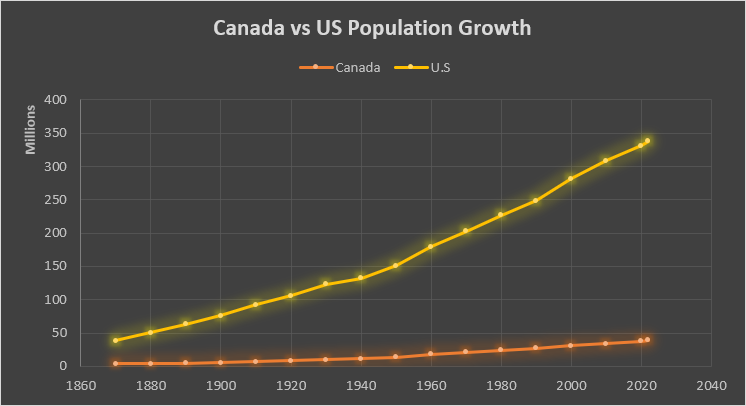
Source: Wikipedia, Canada census
Canada increased its population by over one million in the last year, which is a level of growth we have not seen since…well, ever. We normally got between 250,000 and 400,000 immigrants per year, which was always below the peak of the 1910-1914 years.
Until 2022. We added over 1,000,000 to Canada’s population, which puts us at a whole new level that will shape Canada for years to come.
It was 1862 when things really ramped up. The not-very-united United States was smack in the middle of the Civil War (and five years before Canada even became a nation), but it was still looking far ahead to the future.
The U.S. government passed a bill called the Homestead Act, which was legislation allowing newcomers to 160 acres and citizenship as long as they farmed the land for five years. The United States had recently acquired the state of Texas from Mexico and “liberated” the Great Plains from the native people living there and wanted people to “go upon these wild lands.”
Understand that this is a discussion about numbers, not morality. Displacing indigenous people from their lands is not something we should be proud of, and we continue to struggle with the effects today.
Newcomers flocked to America and its offer of free land. There was no quota system and, with Europe in turmoil and in the middle of a population boom, thousands of every nationality sailed to America.
The U.S. population was approximately 36 million people in the 1870 census, and through births and immigration, this grew by over 12 million per decade for over 60 years. The Homestead Act gave away the equivalent of 2 ½ Californias in land mass until it finally ended in 1986 (Alaska was the last holdout).
Canada is similar in size to the U.S., but much less of our land is farmable. To catch up, we unveiled the Dominion Lands Act a decade later in 1872. It was modelled after the U.S. system (the same 160 free acres) but our version contained a small problem.
Well, several problems, actually.
First, farmers could only receive a land grant at least 20 miles from a railway. Canada had just one trans-continental railway while the U.S. had a vast network of trains criss-crossing the states. Moving grain 20 miles by wagon was extremely expensive compared to what a farmer was paid; so many new farmers who came to Canada starved.
Thousands emigrated to the U.S. for work in the booming manufacturing plants.
Canada finally did away with the 20 mile exclusion zone in 1882, which helped. Our immigration jumped to new highs (150,000 showed up in 1884), but it was still late and kept our numbers well below those of the U.S. In the 1881-1890 decade, almost five times as many immigrants settled in America per year versus Canada.
Second, Canada was more discriminatory in whom it wanted as new citizens. White immigrants of British, Dutch, Belgian, German, Russian, Ukrainian, and Polish origin were preferred, while Italians and Greeks were less preferred. At the bottom were Jews, Asians, Romas, and Black people (source: The Canadian Encyclopedia).
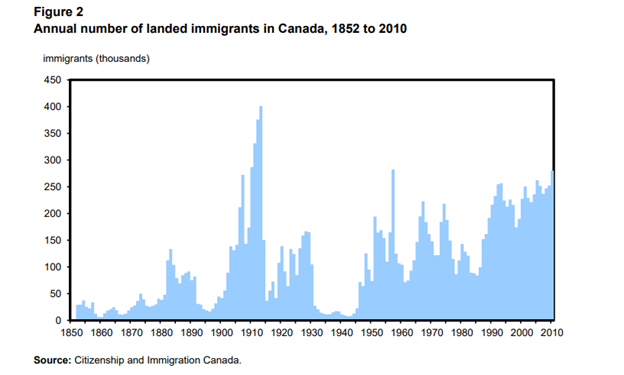
The U.S. had its own restrictions on people of Chinese descent, but Canada’s were broader, and cost us. Canada’s population boom did not really take off until the 1900-1913 period, when more European turmoil sent immigration above 400,000 per year. This number was only surpassed in 2022.
On a personal note, my father’s family arrived from Poland in 1929 under the Dominion Lands Act. They homesteaded in northern Alberta and built a small two-room wooden house to hold two adults and five children while breaking the land by hand.
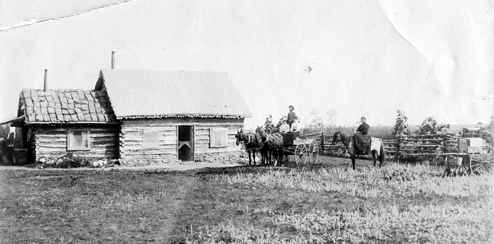
(This is not my father’s house, but it looked very much like this – Encyclopedia of Saskatchewan)
Land was cheap, and people were even cheaper. But simple as it was, there was still a plan and a place to settle all the newcomers, unlike today.
The U.S. continued to out-pull Canada until after WWII. By then, Canada had become more welcoming to the new waves of post-war and communist bloc refugees, and we began outpacing America in immigration percentages. Note the point in the 1950s when Canada’s immigration rate began growing much faster:
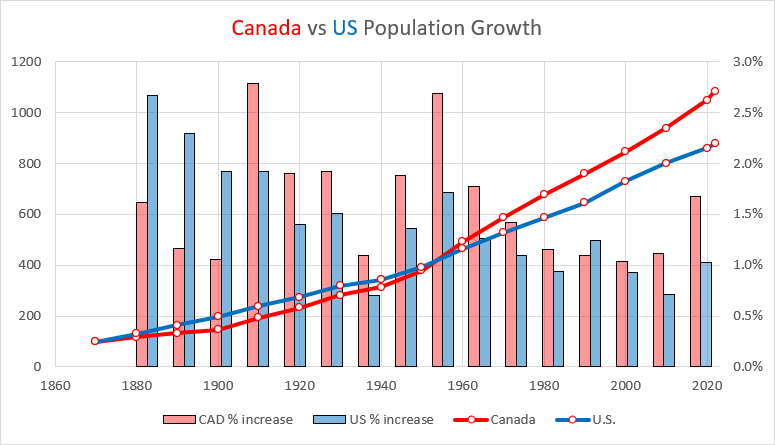
Source: Wikipedia, Canada census
What really set Canada apart, and remains a policy envied by many other nations, was the points-based system introduced in 1967. This laid out a numerical system of priorities based on language, education, and trade skills that determined eligibility of entrance to Canada. The system includes sponsorship of family members, but it remains restricted largely to immediate family, with a big emphasis on skills. In 2017, Canada took in twelve times as many immigrants with skills as the U.S. did (source: Wilson Center).
The U.S. system is much broader and allows almost any relative to sponsor another, no matter how distant, at a priority to those with economic skills. Permanent employment-based immigration is limited to 140,000 per year (Wilson Center) – a very restrictive number.
Having just one safe land border helps Canada immeasurably. We do not face millions of refugees streaming in, as both Europe and the U.S. have experienced in recent years.
Canada is also crafty in how we award working visas. If a foreign student graduates in Canada, he or she receives a diploma and a post-graduation work permit at the same time. This sets many on a path to Landed Immigrant status and eventually citizenship.
Back to today.
In 2022, Canada welcomed over 437,000 permanent residents and 607,000 temporary non-permanent residents (source: bbc.com), a record-breaking year and the highest population growth rate since 1957. Back then, it was home-grown Baby Boom babies and the Hungarian invasion that sent our population surging. Today, it is the influx of Ukrainian, Afghani, Indian, and Chinese people fuelling the rise. Some will return home. Many will stay.
Do more people mean better times?
Rapid population growth helps the economy eventually. Schools need to be built, tax rolls grow, and the pension base builds.
But more people also creates problems. We are woefully short of housing, doctors, and language instructors, just to name a few areas of strain. And even though Canada is one of the most welcoming places in the world for new immigrants – in 2021, 23 per cent of all Canadians were landed immigrants or permanent residents born outside Canada (source: thecanadianencyclopedia.ca) – the existing culture is always resistant to change. Especially when the locals feel outnumbered by the newcomers.
And thanks to a surge in global turmoil, Canada has increased the number of refugee claimants in recent years, which strains the system even further. Refugees cost more and are much slower to become economically productive.
At every other time in history, Canada prospered once it absorbed its new citizens. But it took time. Today, a growing number of new arrivals are considering leaving because housing costs are so high in Canada. Perhaps a recession will lower prices, but labour, land, and commodity costs may refuse to play along. A contributing factor to these shortages is that immigration policy is federal, whereas housing regulations are local. This higher demand for housing can outpace the ability or willingness of local governments to react, which exacerbates the housing crunch.
In the short term, we can pat ourselves on the back for being the fastest-growing of all the G20 nations. We just passed Poland in population size to rank 38th in the world, and Argentina (45 million), Spain (46 million), and South Korea (51 million) are in our sights in the decade ahead (source: Worldometer).
In the long-term, we can also look forward to a more vibrant and youthful economy.
But it is the medium-term that could be rocky. We have to house, educate, employ, and care for a million more people this year. And that is no small task.
Canada’s 39 million people puts us in exactly the same place as America was in 1870. Between births and immigration, the U.S. added 1.2-1.6 million people per year for over 60 years from 1870 to 1930. What would Canada look like if we did that today?
A Very Brief Comment on Interest Expenses
The annual Canadian budget was unveiled this week. No one expects a balanced budget anymore, so a deficit was expected.
It came in higher than forecast, though, and any hopes for a balanced budget in future years were erased in the projections.
What did catch my eye was the expected interest costs.
Anyone with a mortgage or debt today knows how much interest rates have risen. These higher costs also affect our public debt costs.
For example, in 2021, our interest on federal debt was $24.5 billion. That was just seven per cent of Canada’s revenue in that year, so manageable.
But the pandemic sent our debt skyrocketing. Interest charges on our national debt will cost $43.9 billion this year, which means our interest charges are now over 13 per cent of annual revenues.
By 2027, the new budget forecasts over $50 billion in annual interest costs, which means to balance our budget by 2027 (which is no longer planned), we must actually run a surplus of $50 billion just to cover our interest bill.
Everyone really needs interest rates to come down – especially governments!
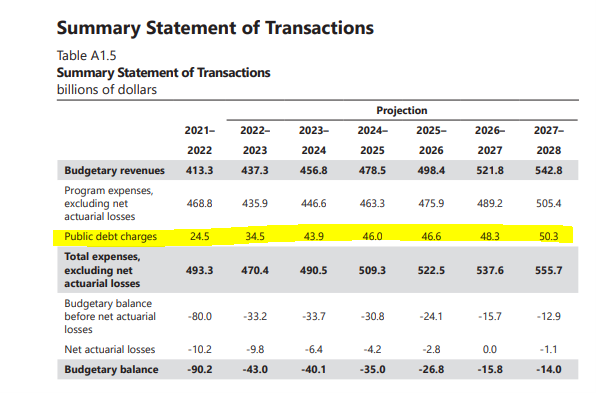
(Canada budget - A Made in Canada Plan summary page)
Quarter-End Markets
Hard to believe, but we are a quarter of the way through 2023. It has been an interesting year so far. Then again, aren’t they all?
Here are approximate returns to Thursday the 30th for the year:

The biggest surprise was the U.S. banking crisis, where three banks failed in very short order. This was followed by Credit Suisse, the Swiss bank, being forced to merge with its biggest competitor, UBS.
Everyone hoped 2023 would be a better year than last year. So far, returns are better, but growth is stalling globally and we are likely headed into a slowdown of some sort. Call it recession if you will, but the strains of the pandemic and the Ukraine war are still being felt.
The surprise in the returns above are global stocks and gold. Both do better when the U.S. dollar is falling, and that is what has occurred. Inflation is refusing to go away and will probably remain higher for years. That is the outcome of too much debt everywhere (as referenced above in Canada’s latest budget).
What holds up best in an inflationary environment? Over time, real estate, stocks, and hard assets like gold do best to preserve your wealth.
On to the next quarter.





